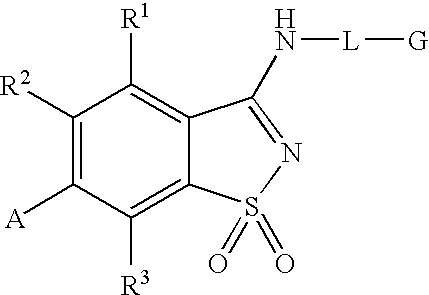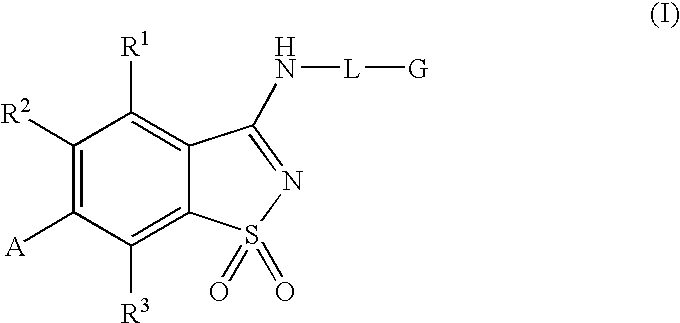Antagonists to the vanilloid receptor subtype 1 (VR1) and uses thereof
a vanilloid receptor and antagonist technology, applied in the field of anti-vanilloid receptor sub-type 1 (vr1), can solve the problems of cell membrane depolarization, and achieve the effects of urinary dysfunction, pain treatment, and inflammatory hyperalgesia
- Summary
- Abstract
- Description
- Claims
- Application Information
AI Technical Summary
Benefits of technology
Problems solved by technology
Method used
Image
Examples
example 1
N-(4-tert-butylphenyl)-6-(3-chloropyridin-2-yl)-1,2-benzisothiazol-3-amine 1,1-dioxide
example 1a
3-chloro-2-(4-methylphenyl)pyridine
[0078]A solution of 2,3-dichloropyridine (0.9663 g, 6.5 mmol), p-tolylboronic acid (0.8569 g, 6.3 mmol) and tetrakis(triphenylphosphine)palladium(0) (0.3618 g, 0.31 mmol) in 0.5 M Na2CO3 (25 mL) and acetonitrile (25 mL) was flushed with N2, sealed and heated at 85° C. for 16 hours. The reaction mixture was cooled to room temperature and the volume reduced by half under vacuum. The concentrate was extracted with dichloromethane (3×20 mL), dried (MgSO4) and condensed to yellow-green oil. The residue was purified by column chromatography, eluted with hexanes:ethyl acetate:dichloromethane (7:2:1)) to provide the title compound as a yellow-orange oil. MS (ESI+) m / z 203 (M+H)+; 1H NMR (DMSO-d6) δ 2.38 (s, 3H), 7.30 (d, J 8.2, 2H), 7.42 (d, J 8.2, 1H), 7.59 (d, J 8.2, 2H), 8.03 (d, J 8.1, 1H), 8.62 (d, J 6.1, 1H); Anal. Calc'd for C12H10ClN.0.1H2O: C, 70.15; H, 5.00; N, 6.82. Found: C, 70.06; H, 4.67; N, 6.67.
example 1b
6-(3-chloropyridin-2-yl)-1,2-benzisothiazol-3-ol 1,1-dioxide
[0079]Chlorosulfonic acid (3.0 mL, 45.1 mmol) was added dropwise over 20 minutes to the product of Example 1A (2.3 g, 11.3 mmol) at about 0° C. The reaction mixture was then heated at 115° C. for 1 hour. The reaction mixture was cooled to 0° C., and treated with ice / ice water. The resulting black oily residue was extracted with dichloromethane (2×30 mL) and the isolated organic extracts were concentrated. The residue was taken into 30 mL of ether: aqueous NH4OH (1:1) and stirred until gas evolution stopped, diluted with H2O (40 mL) and extracted with ethyl acetate (3×50 mL). The combined organic fractions were washed with brine (1×50 mL), dried (MgSO4), filtered and condensed to a white solid, 2.08 g. This white solid was suspended in 1 M NaOH (25 mL) and heated to 80° C. Potassium permanganate (3.55 g, 22.5 mmol) was added in small portions over 40 minutes. The reaction mixture was stirred for another 20 minutes before que...
PUM
| Property | Measurement | Unit |
|---|---|---|
| temperature | aaaaa | aaaaa |
| temperature | aaaaa | aaaaa |
| temperature | aaaaa | aaaaa |
Abstract
Description
Claims
Application Information
 Login to View More
Login to View More - R&D
- Intellectual Property
- Life Sciences
- Materials
- Tech Scout
- Unparalleled Data Quality
- Higher Quality Content
- 60% Fewer Hallucinations
Browse by: Latest US Patents, China's latest patents, Technical Efficacy Thesaurus, Application Domain, Technology Topic, Popular Technical Reports.
© 2025 PatSnap. All rights reserved.Legal|Privacy policy|Modern Slavery Act Transparency Statement|Sitemap|About US| Contact US: help@patsnap.com



